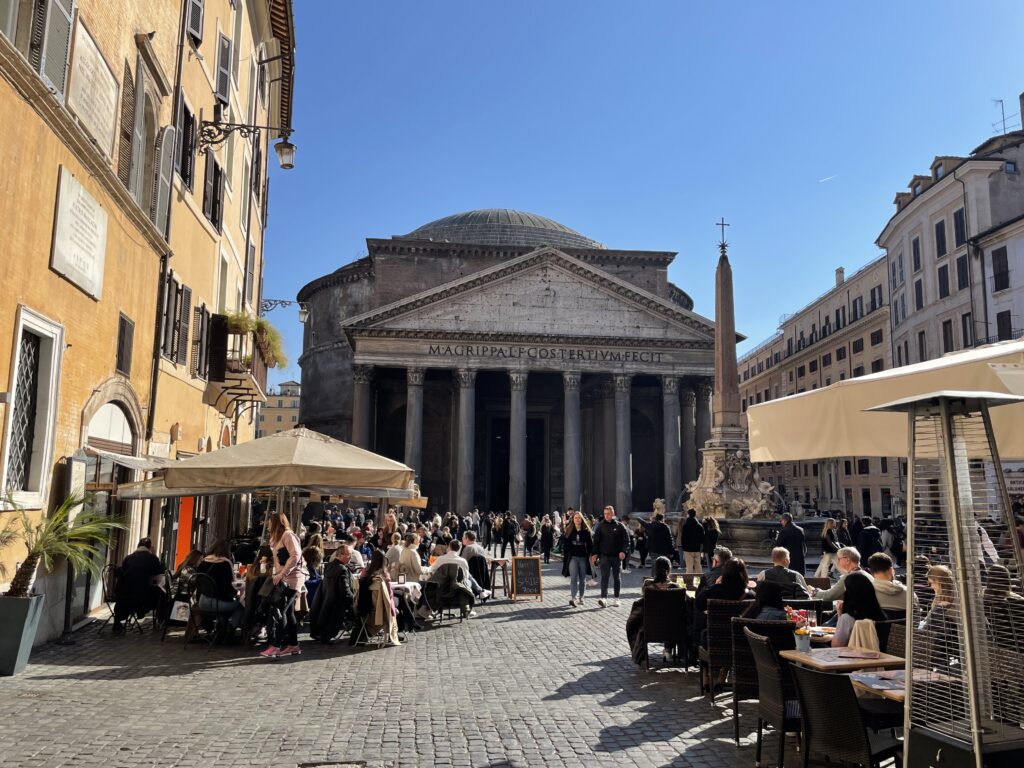Selfie Art: The Pantheon
When I visited my family in Rome in January and March, I saw many important Roman sites, but none were as impressive as the Pantheon. Attached is a picture I took of it, and although I snapped many awe-inspiring pictures of it I do not have a selfie with it. That said, I do have a picture with my father at the Piazza Navona, which is about a thousand feet away, which I’ve also included in this actum.
The Pantheon in my picture was made in the second century AD, and was built by the emperors Trajan and Hadrian. However, prior to the construction of the Pantheon, there was another Pantheon on the same site that was built by Marcus Agrippa, who was one of Augustus’s closest allies. Hadrian decided to keep the inscription honoring Agrippa as a result of this. The current building sits on top of that old foundation, and though the basic structure was built by the Romans in the second century, the building was converted into a church and the current interior was built during the Renaissance.
Like many of the ancient Roman buildings that still survive, the Pantheon is made largely out of stone, but much of the dome is made out of concrete. The most noteworthy feature of the Pantheon is its dome, which to this day is the largest freestanding concrete dome in the world – and it’s nearly 2,000 years old! This awe-inspiring dome has an oculus in the middle that lets ample natural light in, and is part of the dome’s structure.
Being a massive stone building, the Pantheon is displayed exactly where it was built two millennia ago. However, as the city of Rome has evolved, it has found itself nestled snugly into the buildings built up around it, and from the street isn’t visible from more than a block or two away.
Perhaps the most obvious Roman theme that the Pantheon embodies is the general design of it. Being one of Ancient Rome’s most impressive structures, the Pantheon is a poster child for Roman architecture. Domes are a common Roman feature on buildings, and the corinthian columns are also of classic Roman design. In fact, these columns came from Africa – the Romans shipped them to their capital city. The engineering and logistics required to bring them thousands of miles from Egypt to Rome is a marvel in and of itself, and serves as a marker to the ancient Romans’ ability to pull off seemingly unthinkable feats. The logistics of transporting hundreds of tons of stone are something that would have been impossible until only recently.
The dome itself also stands as a testament to the unmatched engineering prowess the Romans had in the ancient world. They successfully made the largest concrete dome in history, and only recently have domes made out of modern materials exceeded the size of the Pantheon’s.
Additionally, the Pantheon stands for the opulence and prowess of Ancient Rome. The building is a massive masterpiece of engineering, and few other ancient societies could produce a structure as large, complex, and well-made as this one. The fact that it’s been used almost continuously since its construction (and is still mostly the original building) stands testament not just to the architectural and engineering abilities of the Romans, but also more broadly to their ability to make a structure in antiquity that was useful for centuries after Rome fell. Its longevity and usefulness has stood the test of time, and the Pantheon is a building emblematic of Ancient Rome: gone, but still very much integrated in our society today.



